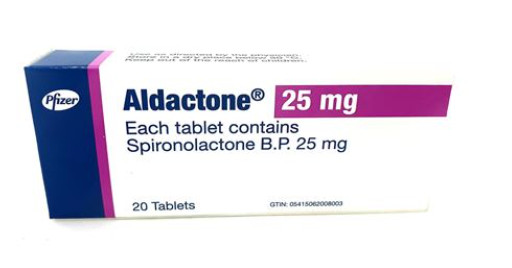
Off label indications
- Hirsutism : 100-200 mg/day twice daily.
- Adult women with inflammatory facial acne.
- Moderate-to-severe acne in women with laboratory evidence of hyperandrogenism :25-200 mg/day in two divided doses.
- Androgenetic alopecia.
- Hidradenitis suppurativa.
Dosage
- Common doses range between 50 and 200 mg daily.
- Begin with 1 or 2 mg/kg/day (50-100 mg/day) as a single daily dose to minimize side effects.
- If no clinical response is seen in 1 to 3 months, consider increasing the dosage to 150 or 200 mg/day as tolerated.
- Good clinical responses can be followed by a reduction of the dosage to the lowest effective daily dose.
Mechanism of action
- Spironolactone is a relatively weak antiandrogen that blocks the androgen receptor and inhibits androgen biosynthesis.
- Inhibitor of 5α-reductase.
Baseline Monitoring
- Serum potassium levels (not required in young healthy patients).
- Baseline blood pressure.
- Check potassium In
- Old age.
- Hx of renal, cardiac disease or hepatic impairment.
- Higher doses 200 mg/d.
- Use of ACE inhibitors.
- Angiotensin II antagonists.
- NSAIDS(e.g Indomethacin)
- Aldosterone blockers.
- K supplement.
- Trimethoprim/sulfamethoxazole (Ask about UTI ttt).
Follow Up Monitoring
- Serum potassium levels at the end of the first month of therapy, or with any increase in dose.
- Patients should be advised to report new onset of muscle cramps or weakness.
- Blood pressure and weight should also be monitored periodically.
- Laboratory monitoring of the abnormal circulating androgen (testosterone or DHEA-S) every 3–4 months may be recommended to ensure successful androgen suppression (not necessary if the values are normal at baseline ).
Side effects
- Hyperkalemia :The most serious but rare, most likely to occur when spironolactone is given to patients with severe renal insuffciency.
- Menstrual disturbances (common).
- Diuresis
- Gynecomastia.
- Breast pain and breast enlargement in women.
- Gastrointestinal symptoms : gastritis, dyspepsia.
- Agranulocytosis (rare) : may occur in patients of advanced age and with hepatic or renal impairment.
- Mild hypotension.
- Dehydration, hyponatremia.
- DRESS syndrome, Stevens–Johnson syndrome or toxic epidermal necrolysis(rare).
- Dry skin.
Contraindications
- Renal insuffciency – acute or chronic.
- Anuria.
- Hyperkalemia.
- Pregnancy.
- Abnormal uterine bleeding.
- Family or personal history of estrogen-dependent malignancy.
Interactions
- Avoid potassium supplements and salt substitutes containing potassium.
- Spironolactone together with trimethoprim/sulfamethoxazole increases the likelihood of hyperkalemia, especially in the elderly.
- Licorice has been found to inhibit the antimineralocorticoid effects of spironolactone, and spironolactone is useful in reversing licorice-induced hypokalemia.
- Concomitant administration of spironolactone with the following drugs or potassium sources may lead to severe hyperkalemia:
- Other potassium-sparing diuretics.
- ACE inhibitors.
- Angiotensin II antagonists.
- Aldosterone blockers.
- Non-steroidal anti-inflammatory drugs (NSAIDs), e.g., indomethacin .
- Heparin and low molecular weight heparin.
- Other drugs or conditions known to cause hyperkalemia .
- Potassium supplements.
- Diet rich in potassium (Cooked spinach-Cooked broccoli-Potatoes-Sweet potatoes-Mushrooms-Peas- Cucumbers- etc).
- Salt substitutes containing potassium.
Pregnancy &Lactation
- Avoid spironolactone in pregnancy.
- Lactation : Consider the developmental and health benefits of breastfeeding along with the mother’s clinical need for the drug, and any potential adverse effects on the breastfed infant from the drug or from the underlying maternal condition.
Precautions
- Women taking spironolactone should use effective contraception to prevent pregnancy.
- Caution in prescribing spironolactone for women with a personal or family history of breast cancer and other estrogen-dependent malignancies.
- Nausea, fatigue, and particularly muscle weakness may be indicative of hyperkalemia.
- Patients should be cautioned about excessive dietary intake of potassium-rich foods (such as bananas and orange juice).
- Excessive potassium intake (eg, salt substitutes, low-salt foods, bananas, nuts) should be avoided.
Drug Info
- Spironolactone influences the ratio of luteinizing hormone (LH) to follicle-stimulating hormone (FSH) by reducing the response of LH to GnRH.
- Canrenone is the primary metabolite, it is the active aldosterone antagonist and is the primary metabolite contributing to the diuretic and antiandrogen activities of spironolactone.
- Administration with food increases the bioavailability of spironolactone and reduces GIT side effects.
- Menstrual problems may resolve after 2–3 months of therapy, If menstrual abnormalities do not improve with time, reduce the dose to to 50–75 mg daily or Add an oral contraceptive or give spironolactone for 21 consecutive days, followed by 7 days off the drug.
- Topical 5% spironolactone lotion and cream have been used to treat some types of acne.
- Effective treatment of hirsutism usually requires longer treatment periods and higher dosages than those used to obtain clinical benefit in the treatment of acne.
- No evidence of breast or uterine cancer.
Was this helpful?
10 / 0
#Spironolactone #Spironolactone in dermatology #Spironolactone indiactiona and dosage in dermatology